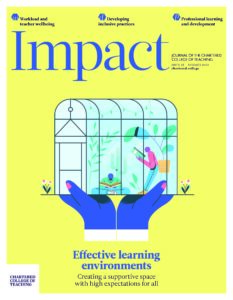Using an appreciative inquiry approach to reflect on the support in initial teacher training (ITT) for autistic trainees

Sarah Alix, Programme Director, North Essex Teacher Training, UK
Introduction
This appreciative inquiry process was undertaken at an initial teacher trainingAbbreviated to ITT, the period of academic study and time in school leading to Qualified Teacher Status (QTS) (ITTInitial teacher training - the period of academic study and time in school leading to Qualified Teacher Status (QTS)) provider. I had an emerging belief that we do not do enough for our autistic trainees, or consider their barriers to learning in enough detail, and therefore we may hinder their progress on the course. I had made some initial observations that some staff had preconceived judgements that the trainees would struggle and may not pass the course, and that this may have an impact on how we support them and how we implement potential strategies. The research generated a development plan for the provision.
As Sajid Javid, the Secretary of State for Health and Social Care, recently stated in foreword to the new autism strategy: ‘Although we’ve come so far over the last decade, there must be no limit to the ambitions of autistic people; they should have the same opportunities as everyone else in society.’ (DfEDepartment for Education - a ministerial department responsible for children’s services and education in England and DHSC, 2021).
Appreciative inquiry – stages and the actions considered
Appreciative inquiry is an approach used to stimulate organisational change. Willoughby and Tosey (2007, p. 517) used this approach to develop their own school improvement, and they outline how they drew together ‘an entire school community in a process of collaborative school review’, which is what I aimed to consider within our provision, with the focus on training for autistic trainees on an ITT course.
Appreciative inquiry focuses on drawing on the positives that are already happening within an organisation and then the dream outcomes. Ludema et al. (2001), as cited in Willoughby and Tosey (2007), highlight the fact that organisations normally focus on the negatives – what is wrong within an organisation – and look at a deficit model, whereas appreciative inquiry focuses on positive and affirmative approaches.
Hammond (2013) clearly outlines the stages and actions of an appreciative inquiry approach as being:
- Define the purpose or goal
- Discover the best of what is
- Dream what might be
- Design how it can be
- Deliver what it will be
- Start again.
Willoughby and Tosey (2007) apply this appreciative inquiry model as a process through which to lead their own school through change and improvement. They define this as emergent practice, in which you move from the discovery phase, through the dream phase, then onto the design phase, and conclude at the delivery phase.
When applying this model to my own setting, I firstly considered the current situation and defined the purpose of the study.
Define phase
The overarching themes and aims (ideal statements) and the proposed focus of the development plan were as follows:
- to be an autism-friendly teacher training provider
- to change existing perceptions of centres and schools working with autistic trainees
- for autistic trainees to gain greater successes on the course through a better training experience and opportunity to pass
- to develop staff knowledge and skills, both at the centre and in schools, relating to autism in the workplace, leading to staff confidence.
Achieving these aims should therefore create an effective learning environment for autistic trainee teachers.
Discovery phase
Willoughby and Tosey (2007) link the discovery and dream phases, gathering thoughts about the provision at its best, and then, following on from this, they consider the dream summit, visualising the provision in years to come. To me, this made sense, and when gathering information in the discovery phase, I also needed to gather stakeholders’ thoughts on the dream phase and the possibilities to come.
I gathered information from key stakeholders to determine what was working well. I sent out a questionnaire (using open questions) to centre-based staff, who included the programme leaders, training and assessment tutors, and administrators, and also to school-based mentors. I also had detailed discussions with two autistic trainees – one past trainee and one current trainee – face to face via Zoom, as well as with the university’s Autistic Support Leader. I conducted thematic analysis on the data collected.
From this discovery phase, I identified that key staff and trainees thought that personal one-to-one support was good and there was always someone to contact. However, this related to the dream phase, and the fact that the one-to-one support needed to be more focused in relation to identified areas of support.
I used the questionnaire as an opportunity to seek feedback from stakeholders with regard to how we could improve further. Questions were asked such as: If we were meeting the needs of trainees with autism, how would we know? What would be different? What would staff notice had changed? What would a trainee notice had changed? All stakeholders related this to success on the course, defining ‘success’ through things such as passing the course with greater confidence, finding the course easier to manage, and a greater understanding of the needs of the trainee and strategies to support them within a challenging ITT context.
I gathered information from stakeholders to determine what it might look like to achieve this in practical terms – the design phase. I looked at how we could reach these goals through gathering further information from occupational health on individual strategies, the need for staff training and the need to change staff perceptions of what could be achieved.
Some of the key findings from the discovery phase
A current issue with provision was related to preconceived ideas about potential outcomes for autistic trainees. One stakeholder even went as far as stating that these create a ‘self-fulfilling prophecy’, where they wondered whether we are almost setting up autistic trainees to fail or to not do as well as they potentially could. Therefore, we needed to break down some of these barriers to learning that are created by staff. In discussion with the human resources (HR) lead, we discovered that training for staff was not as good as we would have hoped around the area of the autism spectrum condition (ASC) and neurodiversity in general. Interestingly, McMahon-Coleman and Draisma (2016) discuss discipline matches and mismatches (for autistic students) within higher education (HE). They argue that a mismatch can occur when a student chooses a course that does not match with their strengths. This then places the student’s progress in danger. I would suggest that some staff within our provision believe that teaching is an inappropriate career choice for autistic individuals. However, I would argue that there are many facets to the spectrum and that some trainees will be able to achieve their goal of becoming a teacher and be successful. Harris (2003) notes that a change in practice involves more than new skills and knowledge, but also addressing and changing attitudes and beliefs. I agree with Lindahl (2011) that a cultural shift is needed here, and therefore this is a key element for development.
Dream phase
The dream phase consisted of asking stakeholders targeted questions around what they would see if they were in an ideal world; it is a solution-focused approach, which is something with which I have worked in the past. The dream phase linked with defining the focus, which is what we are aiming for (as identified in the ‘define phase’ section). We want to become an autism-friendly ITT provider, and in the dream phase, trainees will be successful, find the training course manageable and go on to become successful teachers in employment. This is something that we are not always achieving at the moment. If trainees do pass the course, they can then find it difficult to find employment or stay in employment (as identified in the discovery phase), which is something that needs further research (see the conclusion).
Design phase – create a development plan
The development plan was created, and this took account of the defined goal or proposed focus as set out in the introduction, as well as the findings from the discovery and dream phases.
Specific strategies identified from discussions and questionnaires with stakeholders and autistic trainees were taken forward into the plan. These included ensuring that there was a quiet space to take time out, particularly in between lessons, to gather thoughts and reorganise. This also linked in with further consideration to the trainee timetable, including regular gaps between lessons. At the centre, trainees said that they would appreciate a small peer network to support them with group discussion and presentations during training, which could cause some anxiety currently. Having support setting these up or with arranging to visit other teachers in school to observe practice would be beneficial if they have executive functioning difficulties, as outlined as a difficulty by McMahon-Coleman and Draisma (2016), which led into a conversation with the university’s Autism Support Lead. She described the role of their study support assistants, and I have considered how we could possibly use them, or the format of support that they implement, through our own training and assessment tutors – for example, through weekly meetings to support directly with organisation, time-management and paperwork, or through organising visits to other classrooms. This would link with training for centre-based staff. Ideally, this role may be better linked with the school mentor; however, I think that the time and support needed would not be permissible in a school. The Autism Education Trust (2019a) outline the development of areas to be considered for those with autism in their progression framework. The new framework does account for post-16, and although our trainees are HE learners, there are many relevant areas that still need consideration. For example, a trainee may need further support and guidance with problem-solving, such as taking action to solve a problem within the new context that they are in, or within a professional role such as safeguarding pupils. These are summarised in the Autism Education Trust’s progression framework (2019b), and areas in which individual trainees need support could be identified.
Conclusion
I have made the first steps in the ‘delivery’ phase, beginning the implementation of the development plan. Preliminary findings demonstrate the development of further awareness and support for trainees, as outlined in the plan, which also challenges the perceptions of staff. Further implementation across a number of trainees is needed to assess the value of the approach and the actions within the plan. I also believe that there is still much more to be considered and researched in general, such as whether we can collaborate with other providers and how they are supporting autistic trainees. At a broader level, further research is needed to look at support for autistic teachers and other neurodivergent trainees once the trainee has left us. How are they supported in schools as teachers? What we need to consider further as part of this inquiry is autism, equality and the workplace. Andrews (2016) draws together stories from autistic workers regarding the issues and challenges that they have faced in the workplace, and this is a further piece of research needed in education settings. I believe that there is much more to be considered and actioned within our environment that is currently not covered or addressed sufficiently for autistic trainees entering teaching.
- Andrews J (2016) Autism in the workplace: Untold stories, untapped talent. Ambitious about Autism. Available at: www.ambitiousaboutautism.org.uk/sites/default/files/resources-and-downloads/files/autism-in-the-workplace-report.pdf (accessed 4 March 2022).
- Autism Education Trust (2019a) Progression framework resource. Department for Education. Available at: www.autismeducationtrust.org.uk/resources/progression-framework (accessed 4 March 2022).
- Autism Education Trust (2019b) Progression framework: Links to preparing for adulthood (PfA) outcomes. Available at: https://search3.openobjects.com/mediamanager/middlesbrough/fsd/files/links-to-preparing-for-adulthood-pfa-outcomes-2.pdf (accessed 4 March 2022).
- Fabri M, Andrews P and Pukki H (2020) Best practice for HE lecturers and tutors.
- Hammond SA (2013) The Thin Book of Appreciative Inquiry, 3rd ed. Plano, Texas: Thin Book Publishing Company.
- Harris A (2003) Behind the classroom door: The challenge of organizational and pedagogical change. Journal of Educational Change 4(4): 369–382.
- Lindahl R (2011) The crucial role of assessing the school’s climate and culture in planning for school improvement. Educational Planning 20(1): 16–30.
- McMahon-Coleman K and Draisma K (2016) Teaching University Students with Autism Spectrum Disorder: A Guide to Developing Academic Capacity and Proficiency. London: Jessica Kingsley Publishers.
- Willoughby G and Tosey P (2007) Imagine ‘Meadfield’: Appreciative inquiry as a process for leading school improvement. Educational Management Administration & Leadership 35(4): 499–520.










